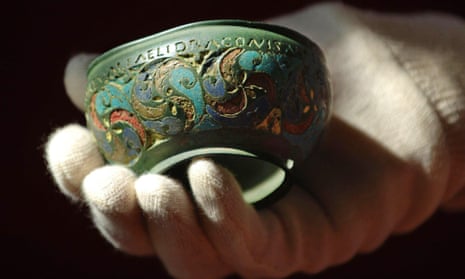The government plans to change the official definition of “treasure” to cover more rare and precious archaeological finds so that such artefacts can be saved for the nation rather than sold to private collectors.
Under the 1996 Treasure Act, objects are designated as treasure trove if found to be more than 300 years old and made of gold or silver, or found with artefacts made of precious metals.
Once officially identified as treasure, such objects become the property of the crown and are made available for acquisition by local or national museums for public display.
But this medieval view of treasure does not cover many of the important discoveries of the 21st century. Metal detecting has produced an increasing number of objects from Roman Britain that do not meet the criteria since they are often made from bronze rather than precious metals.
Additionally, some items of national importance have been lost to the public or have been at risk of being sold to private collectors, the culture department said.
Recent discoveries include the spectacular bronze-enamelled horse brooch, known as the Leasingham horse and dating from between the 2nd and 4th century AD, found in Lincolnshire this year by a detectorist. Resembling earlier designs of the iron age period, the brooch is a rare example and of national significance, yet it could not be designated as treasure. However, thanks to the finder’s generosity, it has been put on display at The Collection Museum in Lincoln.
An exceptionally rare copper-alloy Roman figurine clad in a hooded cloak, known as a birrus brittanicus, was found near Chelmsford, Essex, and nearly lost to public view. Here the government stepped in and imposed a deferred export licence delaying its sale. Chelmsford City Museum was then able to raise funds to purchase the figurine.
The plans for a fresh definition of treasure will aim to ensure that significant finds can be designated as such if they are historically or culturally important, no matter their material qualities.
Announcing the plans, the culture minister Caroline Dinenage said: “The search for buried treasures by budding detectorists has become more popular than ever before and many ancient artefacts now see the light of day in museums’ collections. However, it is important that we pursue plans to protect more of our precious history and make it easier for everyone to follow the treasure process.”
Finders, landowners, museums and members of the public were invited to take part in the consultation process that led to the government’s proposals. Detectorists, archaeologists, museums, academies and curators will have the opportunity to contribute to inform the new definition. Plans to streamline the treasure process will also be introduced.
The popularity of metal detecting as a hobby has led to an increase in treasure cases from just 79 in 1997 to 1,267 in 2017. In 2017 96% of finds that were declared treasure were discovered through metal detecting.
The proposals were welcomed by the British Museum. “We very much welcome working with the [culture department] as it takes forward its work to reform treasure law to protect our shared heritage and encourage best practice amongst finders,” said its head of portable antiquities and treasure, Michael Lewis.
Roger Bland, chair of the treasure valuation committee, also welcomed the announcement, saying the redefinition of treasure would require further work “to ensure the most important finds can be protected”.
